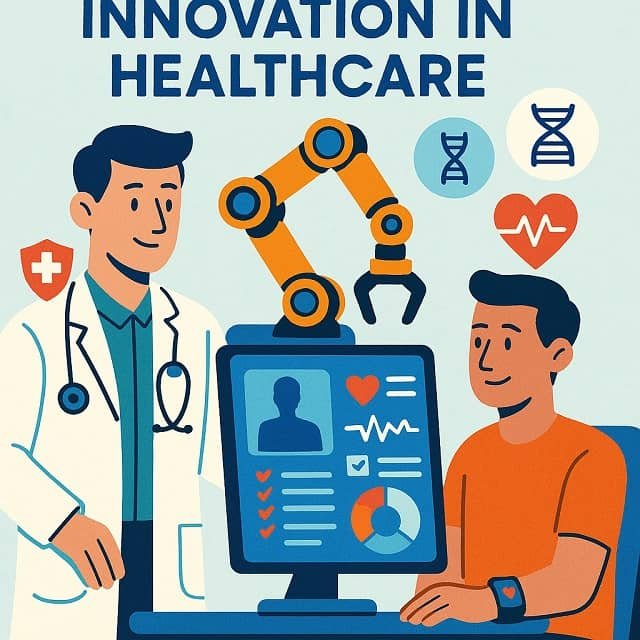
Artificial intelligence (AI) and clinical decision support systems (CDSS) are increasingly being used in healthcare practice (Bellucci, 2022), leading to disruptive innovations in health and promoting new business models in healthcare.
Healthcare innovation is an emerging field of medical science and patient care research that is constantly changing with technological advances and new treatment modalities (Krishnan et al., 2024). In this regard, the use of personalized statistical algorithms, for example, to interpret individual omics data based on their own references, is driving a revolution in personalized medicine, significantly improving global health (Coskun et al., 2024).
Thus, this article delves into what disruptive innovation in health is, explores its definition, characteristics, and the crucial difference with sustainable innovation. We will analyze multiple examples of disruptive innovation in health and examine how it is specifically impacting healthcare service delivery. The goal is to provide a comprehensive understanding of this phenomenon and its potential to create a more accessible, affordable, and effective healthcare system for all.
What is Disruptive Innovation in Health?
The definition of disruptive innovation in health focuses on how new solutions address unmet or ignored needs by dominant market players. Orechwa et al., (2024) indicate that disruptive innovation occurs when novel solutions expand the market to previously ignored populations and, subsequently, become the norm.
Similarly, Brodesser (2024) states that disruptive innovation in the healthcare sector focuses on creating simpler, more affordable, and accessible products or services specifically designed to serve historically underserved market segments.
Often, disruptive innovations may seem inferior according to traditional metrics valued by existing customers (e.g., in a high-end hospital), but they excel in other dimensions such as simplicity, convenience, accessibility, or affordability.
Key points for understanding disruptive innovation in healthcare:
- Origin in Niches: Disruptive innovations often start by serving underserved market segments or creating new markets. Initial customers may be those who could not access or afford existing solutions.
- Simplicity and Affordability: They are often simpler, cheaper, and more convenient than established alternatives.
- Continuous Improvement: Over time, these innovations improve their performance and begin attracting customers from the mainstream market.
- Displacement of Incumbents: Eventually, they can displace established companies and business models that fail to adapt.
In the context of disruptive innovation in healthcare, this involves the introduction of technologies, business models, or processes that make healthcare significantly more accessible and affordable, often shifting care from costly environments like hospitals to more convenient and cost-effective settings like homes, retail clinics, or virtual platforms.
Key Characteristics of Disruptive Innovation in Health
Identifying a true disruptive innovation in healthcare requires looking beyond the hype and analyzing its core attributes. The characteristics of disruptive innovation in health typically include:
- Accessibility: Reduces geographic, economic, or complexity barriers, enabling more people to access care.
- Affordability: Significantly reduces the cost of receiving care or managing health.
- Convenience: Offers services more conveniently for the patient, often outside traditional hours or locations.
- Simplicity: Simplifies processes that previously required specialized expertise or complex clinical settings. They may enable lower-level professionals to perform tasks once reserved for specialists, or even allow patients themselves to manage aspects of their health.
- Focus on Consumer/Patient: Prioritizes the user experience and empowers patients in managing their health.
- Technology as an Enabler: While not all disruptions are technological, technology (digital, mobile, AI, etc.) is often a key enabler to reduce costs and increase accessibility.
- New Business Models: Often involve revenue models, value networks, or operational structures that differ from traditional ones.
It is crucial to understand that not all healthcare innovations are disruptive. Many are incremental or sustainable improvements, which are also valuable but operate under a different paradigm.
Disruptive Innovation vs. Sustainable Innovation in Health
To fully appreciate the impact of disruptive innovation in health, it is essential to distinguish it from sustainable innovation. People often seek terms to understand the difference between them and which might be “better” in a given context.
Sustained Innovation
Focuses on improving existing products and services for the current and more demanding customers of a company. These innovations often make good products even better (e.g., a faster and higher-resolution MRI scanner, a new generation of a drug with fewer side effects, incremental improvements in electronic medical records (EMR) systems). Established companies are often very good at sustainable innovation because it allows them to maintain their market position and satisfy their most profitable customers.
Examples of Sustainable Innovation in Health:
- Advanced robotic surgery that enhances the precision of existing complex surgical procedures.
- New formulations of existing medications that offer a slight improvement in efficacy or convenience (e.g., a once-a-day pill instead of two).
- Software updates for diagnostic equipment that slightly improve image quality.
- Enhanced corporate wellness programs offered by insurers.
Disruptive Innovation
As described earlier, creates new markets or redefines existing ones from the bottom up. Initially, it may not interest the most profitable customers of incumbents, but it eventually redefines the industry.
Which is “better”?
It is not that one is inherently superior to the other. Both are necessary. Sustainable innovation is vital for continuous progress and optimizing care within the existing paradigm. However, disruptive innovation in healthcare is the one that has the potential to address the fundamental cost and access challenges facing the current system. Established players often struggle with disruption because it requires a shift in focus, sometimes cannibalizing their own profitable products or services and adopting business models with initially lower margins.
Examples of Disruptive Innovation in Health
The healthcare landscape is filled with emerging and established examples of disruptive innovation. Here we explore some of the most significant ones, illustrating how they embody the aforementioned characteristics; however, it is important to highlight that technologies can interact with one another, for example, the integration of genomics and big data analytics is driving the evolution toward personalized medicine, presenting significant opportunities to improve disease diagnosis, treatment, and prevention (Hassan et al., 2022):
Telemedicine and Virtual Health
Brodesser (2024) highlights telemedicine as a classic example of disruptive innovation, originally designed for remote areas but now widely accepted, challenging the traditional model of in-person consultations and transforming patient expectations and experiences. According to Orechwa et al., an example of this practice is a diabetic retinopathy screening program via tele-retina in primary care, the “Safer at Home” program to extend care to communities.
On the other hand, Clinical Decision Support Systems (CDSS) analyze data from electronic health records to provide reminders and suggestions to healthcare professionals, which can lead to better care and records (Finch et al., 2023).
- Disruption: Enables medical consultations, diagnoses, monitoring, and follow-ups remotely through communication technology.
- Impact: Breaks down geographical barriers, reduces wait times, lowers costs (transportation, time off work), and improves convenience. Initially seen as inferior for complex cases, it has proven highly effective for primary care, mental health, chronic follow-ups, and specific specialized consultations. It is a clear example of disruptive innovation in health.
Wearables and Remote Patient Monitoring (RPM)
According to Finch et al. (2023), Remote Patient Monitoring (RPM) systems are improving access to healthcare, especially in underserved and remote communities.
- Disruption: Devices such as smartwatches, continuous glucose sensors, and biometric patches collect real-time health data outside the clinical setting.
- Impact: Enables early detection of problems, proactive management of chronic diseases, and empowers patients in their self-care. Shifts monitoring from hospitals/clinics to homes, making it more continuous and less costly.
Artificial Intelligence (AI) and Machine Learning
According to Bellucci (2022), Artificial Intelligence in health is applied in areas like automation of repetitive tasks, robotic exoskeletons, and the Internet of Medical Things (IoMT); it is also used in robotic surgeries, geriatric care, and to recommend personalized treatment plans. Similarly, Hassan et al. (2022) highlight that machine learning algorithms are significant in interpreting genomic data sets and aiding in the design of personalized medicines.
- Disruption: Algorithms that can analyze large volumes of data to assist in diagnosis (e.g., radiology, pathology), discover new drugs, personalize treatments, and optimize hospital operations.
- Impact: Potential to democratize the diagnostic experience (making high-quality analysis more accessible), accelerate research, and improve efficiency. While still evolving, AI performing specific tasks previously requiring human experts fits the disruptive model.
Retail Clinics and Urgent Care Centers
According to Naïla et al. (2024), the “retailization of healthcare” is a concept referring to a paradigm shift within the healthcare sector, where healthcare is integrated into a retail (consumer-oriented) trajectory prioritizing the health consumer’s needs.
Sounderajah et al. (2021) consider retail clinics a disruptive innovation in healthcare processes, potentially reorganizing the way healthcare services are offered, particularly in North America. Health clinics in retail establishments offer easy access and lower costs for non-urgent care and generally specialized services (Rayburn et al., 2024).
Rayburn et al. (2024) reported that in the United States, women, especially those of reproductive age, are more likely than men to seek care at retail clinics; acute care is the most common need, although requests for vaccinations, screenings, treatment of infections, and reproductive health issues were frequent.
- Disruption: Located in pharmacies, supermarkets, or independently, offering basic care, vaccinations, and treatment for minor ailments at transparent prices and convenient hours.
- Impact: Provides a faster, more affordable alternative to emergency rooms or doctor’s offices for non-critical needs. Caters to a segment that values convenience and cost over a long-term relationship with a primary care physician for certain episodes. Its expansion is a clear sign of how healthcare services are being delivered.
Online Pharmacies and Home Medication Delivery
Virtual digital technologies have enormous potential to advance pharmacy and healthcare, from drug discovery and development to the delivery and follow-up of treatments (Trenfield et al., 2022); however, consumer risk perceptions, such as financial, product, origin, and privacy risks, have had a significant direct and indirect effect on their intention to purchase medications through online pharmacies (Assin et al., 2025).
- Disruption: Digital platforms that allow customers to order and receive prescription and over-the-counter medications at home.
- Impact: Improves convenience, medication adherence (especially for chronic patients or those with reduced mobility), and can offer competitive prices due to lower operational costs.
Low-Cost Genomic Sequencing and Personalized Medicine
Genomics holds immense potential to revolutionize personalized care and precision medicine in the near future; this is due to recent spectacular advances in both high-throughput genomic sequencing technology and computational methodologies (Chakraborti and Basu, 2024).
Sahoo et al. (2024) highlight how next-generation sequencing (NGS) has transformed the diagnosis and personalized treatment strategies for cancer by providing comprehensive insights into the genetic landscape of tumors.
Meanwhile, Hassan et al. (2022) explored how mutations in DNA impact the transcriptome and proteome. They mention successful examples of personalized medicine, such as the use of Herceptin in breast cancer and Gleevec in chronic myelogenous leukemia.
- Disruption: The drastic reduction in the cost of sequencing the human genome opens the door to treatments and prevention tailored to individual genetic profiles.
- Impact: Potential to revolutionize oncology, the diagnosis of rare diseases, and pharmacogenomics (adjusting medications based on genetics). Creates a new market for direct-to-consumer genetic testing and targeted therapies.
Omics Technologies
Widdop and Giles (2021), Mohr et al. (2024), and Coskun et al. (2024) highlight the potential of omics technologies to transform healthcare toward more personalized and precise medicine. “Omics” technologies, including genomics, transcriptomics, proteomics, and metabolomics, have experienced significant expansion in medical research over the last two decades due to technological advances in laboratory protocols, data storage, and bioinformatics capabilities (Widdop and Giles, 2021).
- Disruption: The introduction and expansion of “omics” technologies (genomics, proteomics, microbiomics) in research and potentially in medical practice, enabled by technological advances in laboratory protocols, data storage, and bioinformatics capabilities.
- Impact: Potential to transform healthcare toward more personalized and precise medicine. Also, significant expansion of these technologies’ use in medical research over the last two decades.
3D Printing in Medicine
3D printing offers customized solutions, improves medical procedures, fosters research and development, and optimizes the efficiency and effectiveness of healthcare delivery (Nizam et al., 2024). In medicine, 3D printing can be applied to bio-modeling, tissue engineering (bio-printing), manufacturing specialized surgical instruments, creating porous implants, drug delivery, and manufacturing micro-scale medical equipment.
On the other hand, Prakashe et al. (2024) emphasize that 3D printing has revolutionary potential in the healthcare industry, enabling the creation of personalized medications and patient-specific medical equipment.
- Disruption: Creation of customized prosthetics, anatomical models for surgical planning, and even research into bio-printing tissues and organs.
- Impact: Reduces costs and production times for certain medical devices, enables unprecedented customization, and opens new pathways for surgery and tissue regeneration.
These examples of disruptive innovation in health illustrate the diversity of ways in which disruption is reshaping the sector, often combining technology with new service models.
The Impact of Disruptive Innovation in Healthcare Service Delivery
One of the areas most profoundly affected by disruption is the delivery of healthcare services itself. Traditionally, healthcare has been reactive, episodic, and centered around institutions like hospitals and clinics. Disruptive innovation is driving a shift towards a model that is more:
- Proactive and Preventive: Remote monitoring and AI enable identifying risks and acting before serious problems arise.
- Continuous: Care is not limited to occasional visits but is integrated into the patient’s daily life through digital tools and monitoring.
- Personalized: Treatments and prevention strategies are increasingly tailored to individual characteristics (genetics, lifestyle, real-time data).
- Decentralized: Care is shifting from hospitals to homes, communities, and virtual platforms. Retail clinics, telemedicine, and RPM are key examples of this decentralization.
- Patient-Centered: New solutions prioritize convenience, experience, and patient empowerment, giving them a more active role in their health. Vaičiulytė (2024) recommends that healthcare organizations adopt a holistic approach, focusing on patient-centered innovation, among other things.
- Value-Based: The focus is shifting from paying for service volume (fee-for-service) to paying for health outcomes and delivered value (value-based care), a change that disruption can facilitate by allowing for more accurate measurement of outcomes and efficiency.
This shift in healthcare service delivery is not without challenges. It requires adapting reimbursement models, overcoming regulatory barriers, ensuring data privacy and security, and managing resistance to change from established actors and sometimes from the patients themselves.
Challenges of Disruptive Innovation in Healthcare
Despite its immense potential, fostering and implementing disruptive innovation in healthcare is complex. Some describe it as a “wicked problem,” characterized by its complexity, interdependencies, and the lack of clear and unique solutions. The main challenges include:
Regulation
Regulatory frameworks are often designed for the existing system and can be slow to adapt to new technologies and delivery models (e.g., multi-state licenses for telemedicine, AI algorithm approval). Brodesser (2024) highlights that the introduction of disruptive innovation in healthcare becomes particularly challenging and often more costly due to strong regulation.
Interoperability
The lack of standards and the difficulty for different health IT systems to communicate with each other hinders the integration of new solutions and the flow of data necessary for many innovations.
Resistance to Change
Healthcare systems are inherently conservative. Doctors, administrators, and patients may resist adopting new ways of working or receiving care due to inertia, lack of trust, or concerns about quality and safety.
Data Privacy and Security
Handling sensitive health data is critical. Finch et al. (2023) highlights that one of the main challenges is cybersecurity, which must be addressed to protect sensitive patient information and hospital infrastructure. In this regard, digital innovations must ensure robust security measures and comply with strict regulations such as HIPAA (in the U.S.) or GDPR (in Europe).
Health Equity
There is a risk that some disruptive innovations, if not implemented carefully, could exacerbate existing disparities in access to care (the “digital divide”). Reddy et al. (2022) warns that there is a significant digital divide that prevents equitable access to these technologies for a large part of the global population; and this digital divide is primarily caused by issues of connectivity, affordability, and accessibility to technology, but cultural factors and health and digital literacy also play a role.
Clinical Validation and Evidence
Demonstrating the clinical efficacy and economic value of new disruptive solutions requires time and rigorous studies, which can slow down their adoption.
Overcoming these obstacles requires a concerted effort from innovators, providers, regulators, payers, and patients.
The Future is Disruptive
Disruptive innovation in healthcare is not a passing trend; it is a fundamental force that is reshaping and will continue to reshape the sector in the coming decades. Technologies like AI, genomics, digital health, and remote monitoring will continue to mature and converge, creating even greater opportunities to transform how healthcare services are delivered.
Healthcare organizations, both established and new, must understand disruptive innovation in health and its key characteristics. They need to develop strategies to identify, assess, and, when appropriate, adopt or adapt to these innovations. Those who ignore disruption risk becoming irrelevant, while those who embrace it strategically will be better positioned to thrive in the future and, most importantly, to deliver more effective, efficient, and equitable healthcare.
The ultimate promise of disruptive innovation in healthcare is a system that works better for everyone: more accessible to those who are currently underserved, more affordable for individuals and societies, and more focused on keeping people healthy rather than simply treating illness. The path is complex, but the direction is clear: the future of healthcare will inevitably be disruptive.
References
Assin T.J., V., A. George, N., Aboobaker, N. and P., S. (2025), “Emerging market dynamics: risk perceptions, perceived usefulness and E-pharmacy adoption”, International Journal of Pharmaceutical and Healthcare Marketing, Vol. 19 No. 1, pp. 139-159. https://doi.org/10.1108/IJPHM-11-2023-0101
Bellucci, N. (2022). Disruptive Innovation and Technological Influences on Healthcare. Journal of Radiology Nursing, 41(2), 98-101. https://doi.org/10.1016/j.jradnu.2022.02.008
Brodesser, A. (2024). A framework of how to create successful innovation with joint ventures between corporates and startups in the healthcare market [Master Thesis, Technische Universität Wien]. reposiTUm. https://doi.org/10.34726/hss.2024.121351
Chakraborti, T., & Basu, S. (2024). Editorial for BFG special issue: Computational genomics for precision medicine and personalized healthcare. Briefings in Functional Genomics, 23(5), 507-508. https://doi.org/10.1093/bfgp/elae021
Coskun, A., Ertaylan, G., Pusparum, M., Van Hoof, R., Kaya, Z. Z., Khosravi, A., & Zarrabi, A. (2024). Advancing personalized medicine: Integrating statistical algorithms with omics and nano-omics for enhanced diagnostic accuracy and treatment efficacy. Biochimica et Biophysica Acta (BBA) – Molecular Basis of Disease, 1870(7), 167339. https://doi.org/10.1016/j.bbadis.2024.167339
Finch, H., Abasi-Amefon, A., Jung, W., Potter, L., & Palmer, X. L. (2023). Commentary on healthcare and disruptive innovation.
Hassan, M., Awan, F. M., Naz, A., J., E., Alvarez, O., Cernea, A., Luis, J., & Kloczkowski, A. (2022). Innovations in Genomics and Big Data Analytics for Personalized Medicine and Health Care: A Review. International Journal of Molecular Sciences, 23(9), 4645. https://doi.org/10.3390/ijms23094645
Krishnan, R., Manoj, G., Elantheraiyan, P., & Kandasamy, L. (2024). Navigating the Crossroads: Stakeholder Perspectives in Healthcare Innovation. In Revolutionizing the Healthcare Sector with AI (pp. 238-261). IGI Global.
Mohr, A. E., Ortega-Santos, C. P., Whisner, C. M., Klein-Seetharaman, J., & Jasbi, P. (2024). Navigating Challenges and Opportunities in Multi-Omics Integration for Personalized Healthcare. Biomedicines, 12(7), 1496. https://doi.org/10.3390/biomedicines12071496
Naïla Gallouj, Camal Gallouj, Florence Rodhain. Hospital and Retailing. From Retailing in Hospitals to Hospitals in Retailing. European Review of Service Economics and Management, 2024, 1 (17), pp.184-197. ⟨10.48611/isbn.978-2-406-17198-0.p.0185⟩. ⟨hal-04712791⟩
Nizam, M., Purohit, R., & Taufik, M. (2024). 3D printing in healthcare: A review on drug printing, challenges and future perspectives. Materials Today Communications, 40, 110199. https://doi.org/10.1016/j.mtcomm.2024.110199
Orechwa, A. Z., Abhat, A., Amezcua, L., Boden-Albala, B., Buchanan, T. A., Chen, S., Daskivich, L. P., Feldman, B., Gould, M. K., Lynch, C., Meltzer, C. C., Mittman, B. S., Pereyda, M., Raff, E., Robinson, J., Saluja, S., Turner, B. J., Taira, B. R., Trotzky-Sirr, R., . . . Towfighi, A. (2024). 2023 Inaugural Healthcare Delivery Science: Innovation and Partnerships for Health Equity Research (DESCIPHER) Symposium. Learning Health Systems, 8(3), e10442. https://doi.org/10.1002/lrh2.10442
Prakash, A., Malviya, R., & Singh, D. P. (2024). Transformative Potential and Healthcare Applications of 3D Printing. Current Pharmaceutical Design, 30(42), 3311-3321.
Rayburn, W. F., Armstrong, J., & Fairchild, D. (2024). Women Accessing Care at a National Network of Retail Health Clinics. Journal of Women’s Health, 33(6), 774-777.
Reddy, H., Joshi, S., Joshi, A., Wagh, V., Joshi, S. H., & WAGH, V. (2022). A critical review of global digital divide and the role of technology in healthcare. Cureus, 14(9).
Sahoo, O. S., Aidasani, H., Nayek, A., Tripathi, S., Talukdar, J., Gul, A., Kumar, D., Dhar, R., & Karmakar, S. (2024). Role of next-generation sequencing in revolutionizing healthcare for cancer management. MedComm – Future Medicine, 3(4), e70001. https://doi.org/10.1002/mef2.70001
Sounderajah, V., Patel, V., Varatharajan, L., Harling, L., Normahani, P., Symons, J., … & Ashrafian, H. (2021). Are disruptive innovations recognised in the healthcare literature? A systematic review. BMJ innovations, 7(1).
Trenfield, S. J., Awad, A., McCoubrey, L. E., Elbadawi, M., Goyanes, A., Gaisford, S., & Basit, A. W. (2022). Advancing pharmacy and healthcare with virtual digital technologies. Advanced Drug Delivery Reviews, 182, 114098. https://doi.org/10.1016/j.addr.2021.114098
Vaičiulytė, E. (2024). The impact of business management models on healthcare innovation (Doctoral dissertation, Vilniaus universitetas.).
Widdop, J. T., & Giles, E. M. (2021). The future is now? Clinical and translational aspects of “Omics” technologies. Immunology and Cell Biology, 99(2), 168-176. https://doi.org/10.1111/imcb.12404
Editor and founder of “Innovar o Morir” (‘Innovate or Die’). Milthon holds a Master’s degree in Science and Innovation Management from the Polytechnic University of Valencia, with postgraduate diplomas in Business Innovation (UPV) and Market-Oriented Innovation Management (UPCH-Universitat Leipzig). He has practical experience in innovation management, having led the Fisheries Innovation Unit of the National Program for Innovation in Fisheries and Aquaculture (PNIPA) and worked as a consultant on open innovation diagnostics and technology watch. He firmly believes in the power of innovation and creativity as drivers of change and development.





